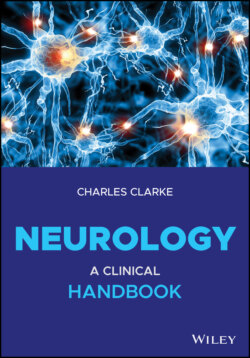Читать книгу Neurology - Charles H. Clarke - Страница 136
Imaging
ОглавлениеThis summary is a stepping‐stone to widely available resources, such as:
htpps://radiopaedia.org
Plain X‐rays have a limited role – skull, spine and skeleton – and radio‐opaque implants and ventricular shunts.
CT (computerised tomography) uses X‐rays to generate thin tomographic slices. CT relies upon tissues attenuating X‐rays to different degrees. Grey‐scale images are adjusted to provide optimal contrast between brain, water (CSF) and bone (Figures 4.1 and 4.2).
Figure 4.1 Axial brain CT: brain windows.
Figure 4.2 Axial brain CT: bone windows. White arrow: ossicles. Black arrow: cochlea. Arrowhead: mastoid bone trabeculations.
Figure 4.3 CT Myelogram. (a): Sagittal. (b): Axial. Intrathecal contrast creates high attenuation CSF, outlines vertebral canal contours, cord (white arrowhead) and nerve roots (white arrows).
Figure 4.4 Axial MR (a) T1w – CSF black. (b) T2w – CSF white, grey matter hyperintense to white matter.
CT myelography images the cord and nerve roots (Figure 4.3).
Magnetic resonance imaging (MRI) uses magnetic fields (1.5 Tesla and 3 Tesla) with radiofrequency pulses to generate signals from protons in water molecules. Two commonly used sequences (Figure 4.4) produce images based on variations in relaxation times of protons, generating T1‐weighted (T1w) and T2‐weighted (T2w) images.
Many other sequences are used – Fluid Attenuated Inversion Recovery (FLAIR), diffusion‐weighted imaging (DWI) and susceptibility‐weighted imaging (SWI). Gadolinium is used for contrast. CT and magnetic resonance angiography (MRA, Figure 4.5) are used for vascular imaging.
Figure 4.5 MR Angiography: contrast MRA of neck vessels.
Advanced MRI, functional MRI, and MR spectroscopy are used in specialist units, and also positron emission tomography (PET) and single‐photon emission computed tomography (SPECT).
Duplex ultrasound, a.k.a. Doppler, is commonly used to assess extracranial carotid arteries. Transcranial Doppler (TCD) gains information from intracranial vessels and has therapeutic possibilities.,
Digital subtraction catheter angiography (DSA) is the gold standard for vascular anatomy. It is invasive, usually via femoral artery puncture. DSA provides images of arterial, capillary and venous phases (Figure 4.6).
Interventional neuroradiology is used to treat intracranial aneurysms and AVMs and is evolving rapidly. Magneto‐encephalography and transcranial magnetic brain stimulation are largely research tools.
Figure 4.6 DSA: (a) arterial and (b) venous phase. Left internal carotid artery injection. White arrowhead: anterior cerebral artery. White arrow: middle cerebral artery branches. Black arrow: superior sagittal sinus.
